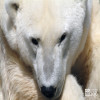Ursus maritimus
The Polar Bear's seemingly "white" coat consists of hollow hairs with no pigment. The fur only appears white by reflecting visible light. Its transparency allows sunlight to penetrate the bears black skin which can absorb heat. For further protection the polar bear has a 3-4 inch layer of fat on his back, thighs, and buttocks. Hair on the soles of the feet provide insulation, traction and silence. The polar bears build is less robust then that of the closely related brown bear with a more elongated neck and head. They are 8-11 ft. long and weigh 700-1400 lbs. with the males being considerably larger.
The most carnivorous of North American bears, the polar bear is a solitary, unsocial hunter capable of consuming 15 to 50 pounds of food in one meal. With excellent senses of hearing, sight and smell (up to 20 miles), this animal in his frozen arctic habitat stands at the top of the food chain. Polar bears possess tremendous strength and dexterity. They are able to pry food from kelp stems as well as knock out a beluga whale; quick enough to snatch lemming from the grass or strong enough to flip a 400 lb. seal into the air. They are excellent swimmers, often found 100 miles at sea.

